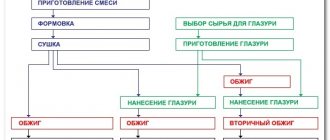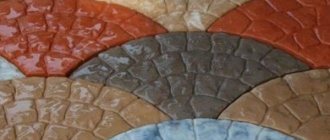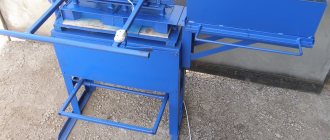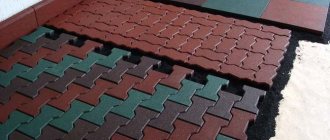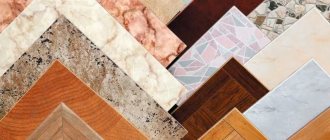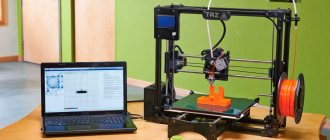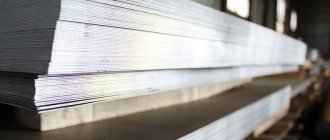To produce paving slabs using the pressing method, you must have special equipment. Manufacturers have launched mass production of such machines, which differ in different capacities and are used to produce specific scales of products. They all have certain functions, but are expensive. When it becomes necessary to make a brick press for paving slabs yourself, you should know its characteristic features.
Figure 1. Vibropress for paving slabs
Raw material base and production technology
igorkznFORUMHOUSE Member
And between cast and vibro-pressed concrete paving stones (45-60 mm thick) – what to choose for the blind area? I understand that vibration-pressed is a little more expensive than casting. Why? Is it stronger than vibration casting?
Elena Maslova Development Director of the Tsemsis plant
First of all, you need to understand the technologies for producing paving slabs. Vibrocasting is an archaic manufacturing technology, is a completely manual method, and is usually carried out in artisanal conditions . The sand-cement mixture (cement+sand+additive) is loaded into reusable plastic molds with a trowel and compacted on a vibrating table. Next, the forms with the products are transferred to racks for storage. The hardened stone is called "paving slabs".
– The process of producing paving stones using the vibration pressing method is fully automated.
At the first stage, the concrete mixture (cement, sand, crushed stone, additive) is loaded into a special matrix - a mold, and the mixture is compacted under the influence of pressure and vibration. The duration of vibration is controlled using special sensors and occurs until the maximum compaction of the concrete mixture and the required height of the products on the entire technological pallet. Next, the products are immediately stripped and the pallets with the products are automatically transferred to special heat-humidity treatment chambers with the required humidity and temperature parameters to achieve the required concrete strength.
With the automatic production method using the vibrocompression method, in contrast to the vibratory casting method, the concrete composition is designed for various areas of operation in accordance with GOST 17608-2017 “Concrete paving slabs”.
The manufacturer simply cannot use any sand, crushed stone and cement to produce tiles. According to GOST, the quality indicators of inert materials and binders at the incoming inspection, and the physical and mechanical characteristics of the quality of concrete of the finished product at the acceptance inspection are strictly regulated:
- compressive strength;
- bending strength;
- water absorption;
- abrasion;
- frost resistance.
Of course, tiles made by vibration pressing will be “stronger,” more durable and denser than tiles made by vibration casting.
As for the blind area, its main purpose is to protect the basement part of the building from possible waterlogging, ensure reliable drainage of precipitation into the storm drainage system and reduce heat loss associated with sudden temperature changes. A high operational load on the blind area is not expected, cars will not drive in, so paving with paving slabs 40 mm thick will be sufficient.
Frame making
Prepared blanks for the frame are welded using electric welding. Weld seams are cleaned using an angle grinder, then the entire workpiece is painted. It is advisable to paint in order to prevent rust: the cement-sand mixture is diluted with water.
The frame must have no in-plane displacements.
Consumer properties of vibro-cast and vibro-pressed tiles
CrossVikForumHouse Member
Tell me, how do vibro-pressed and vibro-cast paving slabs differ in their consumer properties?
Elena Maslova
Vibration-pressed stone is produced in strict compliance with the requirements for the water-cement ratio. Careful selection of the recipe with the obligatory use of coarse and fine aggregates (crushed stone and sand of various fractions) in strictly defined proportions ensures dense packing of aggregates during layer-by-layer compaction of the concrete mixture. Such tiles have high compressive strength, frost resistance (at least 200 cycles in saline solution) and low water absorption (less than 6%) - the main criteria for quality and durability. In addition, the front layer of vibropressed tiles, due to the technological features of production, has a rough surface, which in turn provides an anti-slip effect during winter operation.
Vibro-cast paving slabs
Vibro-cast paving slabs
Vibropressed paving slabs “Sandstone”
Vibration-pressed paving slabs with a textured surface StoneMix
Vibropressed paving slabs ClorMix “Clinker”
– Vibro-cast paving slabs, due to the high water content in the concrete mixture, have high porosity and, therefore, low density and durability. During the winter period of operation, due to frequent temperature changes, which is especially important for the climatic conditions of the North-Western region, water enters the existing pores and capillaries and, through its wedging effect, destroys the structure of the concrete. The surface of vibro-cast tiles is smooth and glossy, which has a negative impact on off-season use - the formation of ice on the surface; in winter, the surface of the tiles can resemble a skating rink.
The table below shows the comparative characteristics of concrete products made using various technologies.
| Name of physical and mechanical properties | The importance of physical and mechanical properties | |
| Pressing | Vibrocasting | |
| Concrete class by compressive strength | B30 | B22.5 |
| Water absorption | Less than 6 % | More than 7% |
| Abrasion | No more than 0.5 g/cm2 | 0.8 g/cm2 |
| Frost resistance | F200 | F100 maximum |
*Note. The frost resistance grade of concrete is taken to be no lower than F200, while the frost resistance of concrete is determined by saturating concrete slab samples before testing with a 5% aqueous solution of sodium chloride, in accordance with GOST 10060.0.
Making a countertop
This element of the press must be made with great strength because it will experience heavy loads.
- The dimensions of the table must match the tabletop.
- The frame is made from channel No. 10 or a corner 7cm by 7cm.
- The blanks are cut, trimmed and welded.
- When welding parts, it is necessary to ensure their evenness - during the welding process, metal structures can bend.
Then a rectangle is cut out of a 10 mm thick steel sheet, then placed on the prepared frame and welded. The top of the tabletop is a sheet.
Advantages of vibropressed tiles
MadbotFORUMHOUSE Member
I want to put paving stones under the parking lot. I read a bunch of sites and topics. I still don’t understand for myself:
- Is vibrocast still less durable than vibropressed?
- Does vibratory casting have any operational advantages? Or just brighter colors?
- Builders say that with a vibrocast it is easier to wash off dirt with the same Karcher, plus, they say, they have had one for many years and nothing. But I see that in the city it is often split (although vibropressed too). In principle, I wouldn’t say that I definitely want a “glossy” surface, so maybe I’ll stick with a vibropressed one and not worry about it? But for myself, I want to figure it out, maybe vibratory casting has some advantages (besides the appearance, which someone likes).
Elena Maslova
1) Vibro-cast tiles are less durable and dense than vibro-pressed tiles because:
- A) it does not contain crushed stone (the main component responsible for the strength and durability of the concrete product).
- B) its production requires a high content of water, which, when the concrete mixture hardens, evaporates and leaves behind large pores and connecting capillaries. During winter operation, they are saturated with precipitation water and salt reagents; when freezing, the water expands in volume and the concrete is destroyed. In the case of vibration compaction, the pores formed in the concrete are scattered and closed; water cannot penetrate into them from the outside.
- C) with vibratory casting technology, the concrete of a product is compacted under the influence of vibration; with vibrocompression technology, compaction occurs simultaneously under the influence of both vibration and punch pressure, the density of the concrete of a freshly molded product is significantly higher.
– 2) Only bright colors. In general, it is believed that vibro-cast paving slabs are more attractive to the buyer due to the variety of shapes and colors in full color. With the maximum permissible dosage of dye, colored vibrocast tiles turn out duller due to the high water-cement ratio during production. Therefore, manufacturers add more pigment to achieve brighter and richer shades.
However, few people know that high dosages of coloring pigment negatively affect the strength of the finished product.
In addition, vibropressing technology began to use high-quality granular pigment, which has high light resistance, does not fade at all, can be used in low dosages, and produces a bright, beautiful product.
– 3) Of course, dirt is washed off much better from a smooth surface, but with a Karcher you can perfectly wash off dirt from the surface of vibropressed tiles. You can actually find cracked vibropressed tiles in urban public spaces. This is due to the fact that there are two methods for producing vibration-pressed tiles - single-layer pressing and two-layer pressing. With a single-layer method, the main components of the concrete mixture are cement and sand, with a two-layer method, the main layer is cement, sand and crushed stone, the front layer is cement and sand. The main layer of concrete is responsible for the strength and durability of the entire structure, and the front layer is responsible for the aesthetic appearance and wear resistance. These are two different structures, which only in a single integrity provide all the requirements for concrete.
Two-layer tiles are denser, more durable and frost-resistant than single-layer tiles, and even more so than vibro-cast ones. Typically, a single-layer tile can crumble if the production technology is not followed, however, there are also cases that the front layer of a two-layer vibro-pressed tile can fly off during operation. The reason is a violation of the manufacturing technology: incorrectly selected moisture content of the front and main layers of concrete. But this is rare; as a rule, the technology of two-layer vibrocompression provides for complete automation of the process and the influence of the human factor in this case is minimized.
Hyperpressing
To ensure the same strength of FEM throughout the thickness, a hyper-pressing technology has been created. It uses two presses, one presses on the punch from above, the second pushes the matrix from below. In this case, the vibrator becomes superfluous, so it is excluded from the design of the press.
Or a single-acting press with high compression force is used. This option is used only for FEMs of small thickness 4 – 6 cm.
To provide a wide range of paving stones - smooth, rough, textured, gray, colored, luminous, hyperpresses of various designs can be used:
- counter pressing two-sided symmetrical - rough front surface, high density of the product, coloring in the mass or only the top layer;
- double-sided asymmetrical counter pressing – “floating table”;
- symmetrical double-sided counter-pressing with vibration - smooth front surface, layer-by-layer painting, including luminescent and fluorescent compounds;
- one-sided pressing with a lower cylinder - high geometry accuracy, flash-free production, maximum possible productivity;
- one-sided pressing with filtration – production of paving slabs of complex configuration, large size, small thickness.
This business is, by default, highly profitable, since instead of sand, the concrete filler is screenings, amounting to 85% by weight. In many industries, screenings are waste, which helps reduce costs. In addition to cement, you need pigment for colored tiles or special paint for luminous paving elements.
Gravity concrete mixers are not suitable for automatic lines. Instead, forced-action concrete mixers are used.
In them, the drum remains motionless, and the blades rotate inside it. The quality of the mixture is higher than in gravity mixers, but the energy consumption is noticeably higher, which increases the cost of production.
For mini-factories, additional equipment of the following types becomes relevant:
- store feeders for pallets/pallets;
- vertical pallet stackers;
- transfer hydraulic grabbers;
- pallet unstackers;
- cement silo;
- automatic pallet packer.
At intermediate stages, equipment is used for removing flash, turning over FEM, packaging roller tables, power cabinets, hydraulic stations, conveyors, racks, synchronizers, and frequency converters.
How does the water-cement ratio affect the characteristics of tiles, visual control method
SerdocForumHouse Member
There are many nuances regarding vibro-compressed tiles, as well as vibro-cast tiles: if the volume of water is exceeded during the production of vibro-cast tiles, the tile will collapse if all other standards are observed. But the production of vibration-pressed mixtures requires a rigid cement-bonded mixture, and excess water leads to sticking in the press, and a drier mixture leads to destruction. Tiles made from a dry mixture absorb water very strongly and take a long time to dry, and with the maximum possible amount of water, on the verge of sticking, they absorb little and dry quickly like natural stone. These two factors are very important and also affect service life and appearance, which is well known to manufacturers.
Elena Maslova
This is true. It is necessary to correctly select the water-cement ratio for any method of producing paving slabs. However, in the case of vibration pressing, this nuance is limited, the production process is automated, any mixer is equipped with humidity sensors, and the dosage of water flow is regulated by a hygrometer. In the case of vibration compaction, it is necessary to obtain the maximum possible moisture content of the concrete mixture, which is assessed visually according to the criterion of the formation of “scores” and “broaches” along the side surfaces of the product.
In the photo on the left - tiles with optimal humidity, on the right - from a dry mixture
Vibration press operation
To start the machine, just perform a series of simple steps. The technology for producing tiles using this method is simple:
- Lubricate the matrix with oil.
- Pour the concrete mixture inside the mold. Place the matrix on the tabletop, ensuring complete alignment with the punch.
- Use the lever to ensure compaction of the mixture by turning on the vibration mechanism for a while.
- Remove the product from the mold and send it to dry.
To determine the mixture composition required for paving slabs, its desired characteristics are taken into account. Traditionally, the components are cement with sand, crushed stone screenings, and pigment diluted with water. When you manage to make a brick making machine yourself, the production process itself is much simpler. It is only necessary to scrupulously follow the recipe composition of the ingredients used to prepare the mixture.
Conclusion
Vibropressed paving slabs are a universal, extremely strong and durable material. And if at the beginning of the development of technology the choice of shapes and colors was limited, today a brick making press is in no way inferior to casting in terms of decorativeness. Naturally, if we talk about high-quality factory products. Coupled with compliance with paving technology, tied to the type of soil and groundwater level, the finishing layer of vibropressed tiles is “set and forget” until you get tired of it.
You can read more about paving technology for different conditions in one of the previous materials. For those who have an acute issue of frost heaving - about budget and reliable paths for clay soils and high groundwater level. The video shows the rules for laying paving slabs from a specialist.
Subscribe to our Telegram channel Exclusive posts every week
Components for brick making press
To create a brick making machine, you need to imagine how it works (you can see the operation of a factory machine), the principle is the same.
Main components of the machine:
- Plate;
- Tabletop;
- Press;
- Vibromechanism.
Before starting production, it is important to make drawings of the parts. You can find several options for the machine on the Internet. You should choose based on the availability of components.
There are options for simpler brick presses, and there are more complex and powerful ones. To calculate the size of the machine, you need to decide on the size of the tile and the number of matrices. There is no point in creating a device for one form.
Results
Tiles pressed on a vibrating press are characterized by excellent performance characteristics: they are excellent at withstanding severe mechanical damage and are highly resistant to precipitation and the action of chemicals. As for the industrial scale of production, its production has a high level of relevance, which has the same profitability as gold mining in the world at promising mines. The payback period for a business producing this building material is 2-3 years.
Electric motor for brick making machine
For the operation of a homemade concrete block press, an electric motor is required. The engine should be selected more powerful. It is recommended to use VI99/E. You can use any electric motor by connecting it with a belt to an eccentric.
Depending on the type, the engine is mounted below on a table top or on a work table. The electric motor is secured with bolts. To prevent the nuts from loosening due to vibration, engraving washers are used.
How to assemble a vibrating table correctly
- Before assembly, it is advisable to treat metal parts with an anti-corrosion solution to prevent the appearance of rust. For example, primer GF-021 LAKRA (125 rubles/kg) or enamel paint “Special forces primer-enamel for rust” (383 rubles/0.8 kg). For metal that is already affected by corrosion, you need to use special primers, such as EP-0180 primer (188 rubles/kg).
- The components of the vibrating table are connected by a weld. The choice of rigid fastening is due to the fact that the bolts can become loose during vibration and reduce the rigidity of the support. If you need to make a collapsible structure, bolts are used that need to be tightened periodically.
- The motor driving the vibration table must not touch the ground. After installing it, it is advisable to carry out a test run of the equipment in order to check the amplitude of vibration, the stability of the structure and the stiffness of the springs.
- The length of the support legs must be the same. In addition, the table installation location must be level so as not to create distortion when installing the vibrating table. It is reasonable to fix the table motionless on the base. Either using concrete mortar or using anchors.
Attaching the table top to the table
One way to secure a tabletop is to install it on springs. It is enough to install six springs about 12 cm long and 6 cm in diameter, which have great rigidity.
For springs, cups are cut out of the pipe. The diameters of the pipe and spring must match. The spring should sit tightly in the glass by one third of its length. The glasses are welded to the table and to the countertop, precisely marking their location points.

